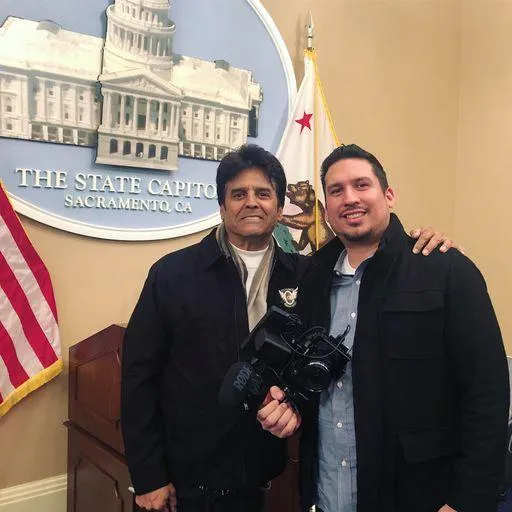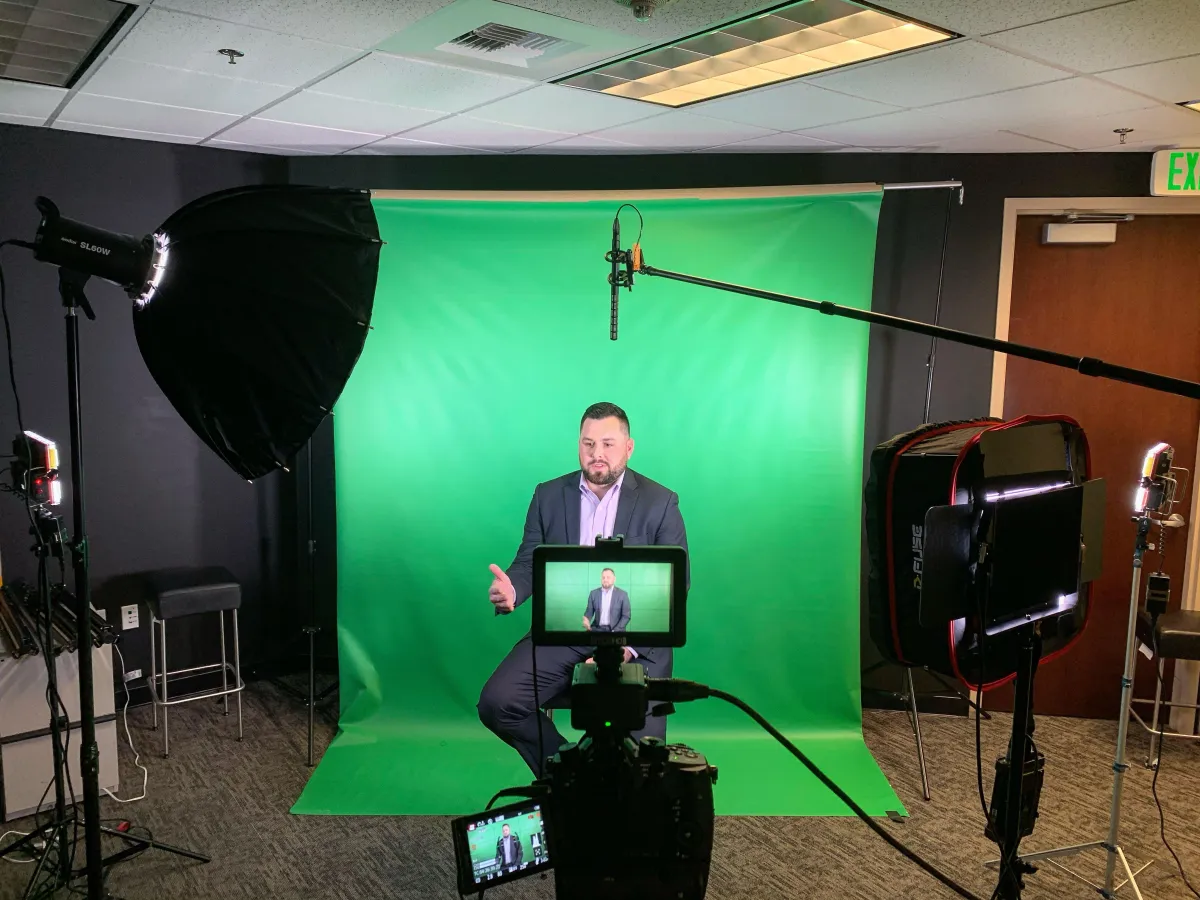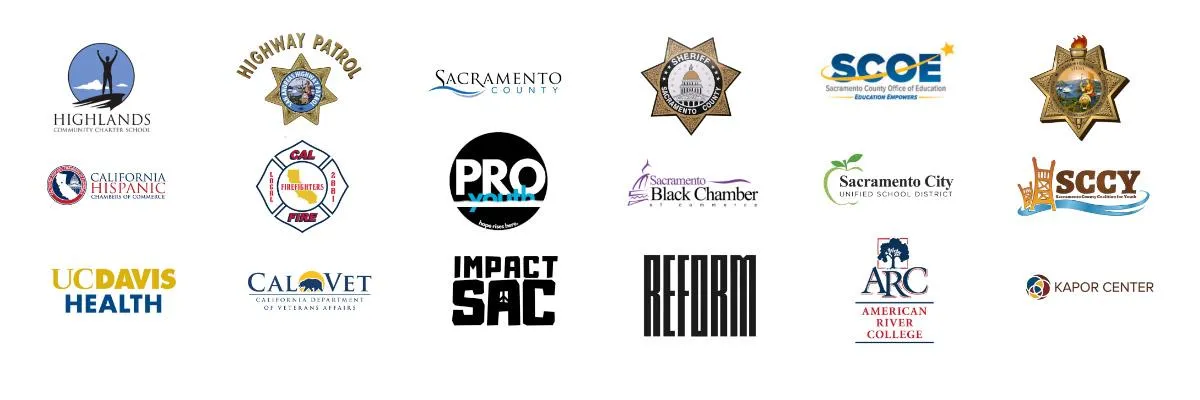
Podcasting
video content continues to dominate the content marketing landscape, reflecting its immense power and influence.

Storyboarding
Scriptwriting and Character Development


Production
Directing, Editing, and Post-Production


Marketing
A plan to maximize your digital reach
Amplify your voice and build a loyal audience through the power of audio.
Our end-to-end podcasting services help you create, produce, and distribute engaging content that establishes your authority and connects with listeners.
What we offer
Podcast strategy and concept development
Professional recording and audio engineering
Editing and post-production
Show notes and transcript creation
Artwork and branding design
Distribution to major podcast platforms
Promotion and audience growth strategies


We create tailored solutions
Corporate communications
Marketing campaigns
Social media content
Training and e-learning
Event coverage
Whether you're looking to share industry insights, tell compelling stories, or educate your audience, we'll guide you through every step of the podcasting journey.
From choosing the right equipment to analyzing listener metrics, our team ensures your podcast sounds great and reaches the right ears








Turn your expertise into episodes that inform, entertain, and inspire. Let's create a podcast that resonates with your audience and supports your brand's mission.
Portfolio
Our 4 Step Process
A simple and proven way to get results

Discover
We help you discover stories that help you reach your goals.

Design
We help you design the look and feel of your messaging.

Direct
A collaborative process of directing each project.

Distribute
We help you reach your goals with a process and plan for outreach.
Behind the scenes










Trusted by

Recent Articles

The Importance of Video Marketing
In today's digital age, video marketing has emerged as a powerful tool for businesses to engage, captivate, and convert their target audience.
With the rise of social media and the ever-increasing demand for visual content, incorporating videos into your marketing strategy has become essential for staying competitive in the market.
We will delve into the importance of video marketing and provide key insights on how it can save you time while maximizing your results.
The Power of Video Marketing
Video marketing has proven to be a game-changer for businesses, as supported by the latest statistics and research. Here are some compelling insights that highlight the impact of video marketing:
1. Increased Engagement: According to HubSpot, videos receive 66% more qualified leads per year and generate a 54% increase in brand awareness. Additionally, videos on landing pages can increase conversions by 80%.
2. Consumer Preferences: Cisco predicts that by 2022, online videos will make up more than 82% of all consumer internet traffic. This shift demonstrates the growing preference for video content over other forms of media.
3. Social Media Dominance: Social media platforms heavily prioritize video content. For instance, Facebook users watch around 8 billion videos daily, and LinkedIn users are 20 times more likely to share a video than any other type of post.
4. Mobile Consumption: With the rise of mobile devices, video consumption has skyrocketed. Mobile video consumption grows by 100% every year, making it crucial for businesses to optimize their videos for mobile viewing.
5. Search Engine Optimization (SEO): Websites with videos are 53 times more likely to rank on the first page of Google search results. Incorporating video content into your website can significantly enhance your SEO efforts and increase organic traffic.
6. Return on Investment (ROI): Wyzowl reports that 83% of businesses say video provides a good ROI. With video content's ability to drive conversions and increase sales, it has become a valuable investment for businesses of all sizes.
These statistics and research underline the immense impact that video marketing can have on businesses.
Higher engagement rates, conversion rates, and brand recall compared to other forms of content.
Videos have a unique ability to drive higher engagement rates, conversion rates, and brand recall compared to other forms of content. Here's a closer look at how videos accomplish these objectives:
1. Enhanced Engagement:
- Visual and auditory stimulation: Videos combine visual imagery, motion, sound, and storytelling to create a captivating experience. This multi-sensory approach engages viewers on a deeper level, holding their attention for longer periods.
- Emotional connection: Videos have a powerful impact on viewers' emotions. Through storytelling, music, and visuals, videos can evoke strong emotions that resonate with the audience. Emotional engagement fosters a stronger connection to the brand, resulting in increased engagement.
2. Improved Conversion Rates:
- Demonstrating product or service value: Videos provide an excellent platform to showcase products or services in action. Demonstrations, testimonials, and case studies presented in a video format help potential customers understand the value and benefits more effectively, leading to higher conversion rates.
- Call-to-action optimization: Videos can incorporate clear and compelling calls-to-action (CTAs) within the content. Whether it's encouraging viewers to visit a website, subscribe, or make a purchase, well-placed CTAs in videos prompt immediate action from engaged viewers, boosting conversion rates.
3. Increased Brand Recall:
- Visual storytelling: Videos excel at storytelling, allowing brands to convey their message and values in a memorable and impactful way. The combination of visuals, narrative, and emotions creates a lasting impression on viewers, enhancing brand recall.
- Association with positive experiences: When viewers have a positive experience watching a video, they are more likely to associate those positive emotions with the brand. This association contributes to better brand recall and strengthens brand affinity.
Compared to other forms of content, videos offer a dynamic and immersive experience that grabs attention, conveys information effectively, and leaves a lasting impression. By leveraging videos in marketing campaigns, businesses can enjoy higher engagement rates, increased conversion rates, and improved brand recall, ultimately driving their success in the digital landscape.
Growing popularity of video consumption on various platforms
The popularity of video consumption across various platforms has been skyrocketing, underscoring the urgent need for businesses to embrace and leverage this growing trend. Here's a closer look at the remarkable surge in video consumption:
1. Social Media Dominance:
- Facebook: With over 2.8 billion monthly active users, Facebook has become a major hub for video content. The platform reported an average of 8 billion daily video views.
- YouTube: As the second-largest search engine after Google, YouTube boasts over 2 billion monthly logged-in users who watch more than 1 billion hours of video each day.
- Instagram: This visual-centric platform witnessed the rapid rise of video content through features like Stories, IGTV, and Reels. Over 500 million people use Instagram Stories daily.
- TikTok: This short-form video platform gained tremendous popularity, amassing over 689 million global active users monthly. Users spend an average of 52 minutes per day on the app.
2. Streaming Services and Online Video Platforms:
- Netflix: With more than 200 million subscribers worldwide, Netflix revolutionized the way people consume video content, paving the way for streaming giants like Amazon Prime Video, Hulu, and Disney+.
- Online video platforms: Platforms like Vimeo and Wistia have gained traction, providing businesses with the means to host and distribute their video content seamlessly.
3. Mobile Consumption:
- Mobile devices have become the primary medium for video consumption. According to eMarketer, mobile accounts for over 60% of digital video plays globally.
- The convenience and accessibility of smartphones and tablets have contributed to the exponential growth of mobile video consumption.
This surge in video consumption across social media, streaming services, and mobile devices signifies the changing preferences and behaviors of consumers. Businesses need to recognize the immense potential and reach of video content to effectively engage and connect with their target audience. By embracing this trend and strategically integrating video marketing into their strategies, businesses can tap into the vast and engaged audience, driving brand awareness, engagement, and ultimately, business growth.
Emotional impact of videos on viewer engagement
Videos have a profound impact on the human psyche, as they tap into our emotions and create a deeper connection with the audience. Understanding the psychological aspects of video marketing helps explain why videos are so effective in evoking emotions and forging meaningful connections. Here's a closer look:
1. Emotional Engagement:
- Visual and auditory stimulation: Videos combine visuals, motion, sound, and music to create a multisensory experience. These elements work together to captivate viewers' attention and stimulate their senses, triggering emotional responses.
- Empathy and relatability: Videos have the power to portray relatable situations, characters, or stories that resonate with viewers on an emotional level. When people see themselves or others going through similar experiences, they develop a sense of empathy, fostering a stronger connection with the content and the brand behind it.
2. Storytelling and Narrative:
- The power of storytelling: Humans are hardwired to respond to stories. Video marketing allows brands to leverage storytelling techniques to engage viewers emotionally. Through narratives, videos can evoke curiosity, suspense, joy, or even nostalgia, forming a memorable and impactful experience.
- Building brand identity: Videos enable brands to convey their values, personality, and mission in a compelling and relatable way. By aligning their storytelling with their target audience's aspirations and emotions, brands can create a deeper emotional connection and strengthen brand identity.
3. Visual and Verbal Cues:
- Non-verbal communication: Videos utilize visual cues such as facial expressions, body language, and colors to convey emotions without explicit verbal communication. These non-verbal cues enhance the emotional impact and make the content more engaging and authentic.
- Tone of voice and narration: The use of voice-over narration in videos influences the emotional response of viewers. The tone, pace, and intonation of the narrator can evoke specific emotions, enhancing the overall emotional connection with the content.
4. Memory and Recall:
- Emotional arousal and memory retention: Emotionally charged videos have a greater impact on memory retention. When viewers experience emotions while watching a video, it creates a stronger memory imprint, leading to better brand recall and message retention.
- Associative learning: By associating positive emotions with the brand through compelling videos, businesses can create positive associations that influence future purchasing decisions and foster long-term loyalty.
Understanding these psychological aspects helps marketers craft video content that resonates with their audience on a deeper level. By evoking emotions, leveraging storytelling techniques, and employing visual and verbal cues effectively, businesses can create impactful videos that forge meaningful connections, increase engagement, and drive brand loyalty.
The power of storytelling through visuals and effect it has on memory
Several successful video campaigns have effectively leveraged emotional storytelling to engage and inspire viewers. Here are a few noteworthy examples:
1. Always - "Like a Girl":
Always, a feminine hygiene brand, launched a powerful video campaign challenging stereotypes associated with the phrase "like a girl." The video featured young girls and adults demonstrating how society perceives doing things "like a girl" as weak or inferior. By showcasing the girls' strength and resilience, the campaign aimed to empower women and redefine the phrase's meaning. The emotionally charged video garnered over 90 million views and sparked a global conversation about gender equality.
2. Google - "Dear Sophie":
Google's "Dear Sophie" campaign focused on the emotional bond between a father and his daughter. The video followed the father's journey of creating a digital time capsule for his daughter, documenting precious moments of her life as she grew up. The heartwarming narrative evoked nostalgia, love, and the importance of preserving memories. The campaign resonated with viewers and showcased how Google products can play a role in capturing and cherishing life's precious moments.
3. Dove - "Real Beauty Sketches":
Dove's "Real Beauty Sketches" campaign aimed to challenge women's perceptions of their own beauty. The video featured a forensic artist sketching women based on their self-descriptions, followed by sketches based on descriptions from strangers who had interacted with the women. The stark difference between the two sketches revealed how women tend to underestimate their own beauty. The emotional impact of the campaign sparked conversations around self-esteem and the unrealistic beauty standards imposed by society.
4. Nike - "Dream Crazy":
Nike's "Dream Crazy" campaign featured Colin Kaepernick, the former NFL quarterback known for his activism. The emotionally charged video showcased athletes overcoming obstacles, defying expectations, and making a positive impact. The campaign aimed to inspire viewers to pursue their dreams fearlessly and stand up for what they believe in. Despite the controversy surrounding the ad, it generated significant attention and sparked conversations about social issues and the power of perseverance.
These examples demonstrate how emotional storytelling can captivate audiences, create a deeper connection with the brand, and inspire viewers to take action or engage in meaningful discussions. By leveraging emotional narratives, brands can effectively convey their values, ignite conversations, and make a lasting impact on viewers.
Understanding the various formats and styles
Different video formats, such as explainer videos, animations, and motion graphics, are highly effective in simplifying complex concepts. Let's explore each format and its benefits:
1. Explainer Videos:
Explainer videos use concise and engaging narratives to break down complex concepts into easily understandable and relatable content. Key features include:
- Clear storytelling: Explainer videos follow a structured narrative, presenting information in a logical sequence, and simplifying complex ideas through storytelling techniques.
- Visual aids: Visual elements such as illustrations, graphics, and text overlays are used to support the explanation and make it more visually appealing.
- Voice-over narration: A professional voice-over guides viewers through the video, providing additional clarity and enhancing understanding.
2. Animations:
Animated videos bring concepts to life by using characters, objects, and visual metaphors. Key features include:
- Visual representation: Animation allows abstract or intangible ideas to be represented visually, making them more tangible and relatable.
- Simplicity and creativity: Animations can simplify complex processes or concepts by breaking them down into easily digestible visuals and creative storytelling.
- Flexibility: Animation provides the freedom to depict scenarios, transitions, and visual metaphors that may be challenging to capture with live-action footage.
3. Motion Graphics:
Motion graphics combine text, illustrations, and animations to present information in a visually appealing and dynamic manner. Key features include:
- Visual hierarchy: Motion graphics effectively use typography, color, and movement to guide viewers' attention and emphasize key points.
- Data visualization: Complex data sets or statistics can be transformed into engaging visuals, making information more comprehensible and memorable.
- Interactive elements: Motion graphics can incorporate interactive elements, allowing viewers to explore the content at their own pace or engage in interactive quizzes or demonstrations.
These video formats simplify complex concepts by leveraging visual storytelling, creative animations, and engaging motion graphics. By using these formats, businesses can effectively communicate intricate ideas, educate their audience, and increase understanding and retention of key messages. Whether it's through explainer videos, animations, or motion graphics, these formats bring clarity and engagement to complex subjects, making them accessible to a wide range of viewers.
Enhancing Brand Awareness
Utilizing social media platforms to amplify video content is a powerful strategy for businesses to expand their reach, engage with their audience, and maximize the impact of their videos. Here's how businesses can leverage social media to amplify their video content:
1. Choose the Right Platforms:
- Identify the social media platforms where your target audience is most active. Consider popular platforms like Facebook, Instagram, Twitter, LinkedIn, YouTube, and TikTok.
- Tailor your video content to each platform's unique features and audience preferences. For example, short and visually appealing videos work well on Instagram and TikTok, while longer-form videos may thrive on YouTube and Facebook.
2. Optimize Video Metadata:
- Craft compelling titles, descriptions, and tags for your videos. Use relevant keywords to improve searchability and ensure your video content aligns with users' interests.
- Add relevant hashtags to increase discoverability and enable your video to reach a wider audience.
3. Native Uploads:
- Upload your videos directly to each social media platform rather than sharing links from external sources. Native uploads tend to receive higher visibility and engagement as the algorithms prioritize platform-native content.
4. Engage and Interact:
- Respond to comments and engage with your audience. Encourage viewers to like, share, and comment on your videos to boost visibility and reach.
- Run contests or challenges related to your video content to encourage user-generated content and increase engagement.
5. Leverage Paid Advertising:
- Utilize social media advertising options to promote your video content to a targeted audience. Platforms like Facebook, Instagram, and YouTube offer robust advertising tools to reach specific demographics and interests.
6. Collaborate and Partner:
- Collaborate with influencers, industry experts, or complementary brands to co-create and share video content. This helps to tap into their existing audience and expand the reach of your videos.
7. Analyze and Optimize:
- Utilize the analytics provided by social media platforms to track video performance, engagement metrics, and audience demographics. Use these insights to optimize your video strategy and create content that resonates with your audience.
By effectively utilizing social media platforms, businesses can amplify their video content, increase visibility, and engage with a wider audience. The combination of targeted distribution, audience interaction, and data-driven optimization allows businesses to maximize the impact of their videos and achieve their marketing goals.
Saving Time with Video Marketing
Streamlining the content creation process through video production is crucial for businesses to efficiently produce high-quality videos while saving time and resources. Here are key strategies to streamline the video production workflow:
1. Pre-production Planning:
- Define clear objectives: Determine the purpose, message, and target audience for your video. Establishing clear goals helps guide the entire production process.
- Scriptwriting and storyboarding: Develop a well-written script and create a storyboard to visualize the shots, transitions, and overall flow of the video. This pre-production planning ensures a clear direction for the shoot.
2. Efficient Production:
- Equipment and location readiness: Ensure all necessary equipment and shooting locations are prepared in advance to avoid delays and disruptions during production.
- Optimize shooting schedules: Plan and organize shoots efficiently by grouping similar scenes or locations together to minimize setup and breakdown time.
- Collaboration and delegation: Clearly define roles and responsibilities for each team member involved in the production process to maximize efficiency and avoid duplicating efforts.
3. Post-production Workflow:
- Media organization: Create a structured system for storing and organizing media files to easily locate and access the required footage, graphics, and audio assets.
- Video editing templates and presets: Develop standardized templates and presets for editing software to streamline the editing process, maintain consistency, and save time on repetitive tasks.
- Feedback and revisions: Establish clear communication channels with stakeholders to ensure timely feedback and revisions, avoiding unnecessary delays in the editing process.
4. Repurposing and Versioning:
- Repurpose content: Explore opportunities to repurpose existing video content, such as creating shorter clips, teaser videos, or snippets for social media platforms, maximizing the value and reach of your video assets.
- Versioning for different platforms: Tailor videos for specific platforms by creating optimized versions with appropriate aspect ratios, durations, and captions, ensuring maximum compatibility and engagement.
5. Automation and Tools:
- Utilize video editing software: Leverage video editing software with advanced features and automation capabilities to streamline repetitive tasks, enhance efficiency, and improve productivity.
- Collaboration tools: Employ project management and collaboration tools to facilitate seamless communication, file sharing, and feedback exchange among team members, regardless of their location.
By implementing these strategies, businesses can streamline the video production process, saving time and resources while maintaining the quality and effectiveness of their video content. Streamlined workflows allow for efficient content creation, ensuring videos are delivered on time, within budget, and aligned with the overall marketing objectives.
Saving Time
Repurposing videos for multiple platforms and marketing channels is a smart strategy that allows businesses to maximize the reach and impact of their video content. Here's how businesses can effectively repurpose videos:
1. Understand Platform Requirements:
- Each platform has its own specifications for video format, duration, aspect ratio, and file size. Familiarize yourself with these requirements to ensure your repurposed videos are optimized for each platform.
2. Edit for Platform-Specific Content:
- Tailor your videos to suit the preferences and expectations of each platform's audience. This may involve making adjustments to the editing style, visuals, captions, or even incorporating platform-specific features such as interactive elements or filters.
3. Create Shorter Versions:
- Cut down longer videos into shorter, more concise versions. These condensed videos can be used for social media platforms like Instagram, Facebook, Twitter, or as teasers to generate interest and drive traffic to the full-length video.
4. Extract Highlights and Snippets:
- Identify key moments or highlights from your videos and extract them as standalone snippets. These can be shared as engaging bite-sized content on social media, blog posts, newsletters, or used as promotional material.
5. Add Captions and Subtitles:
- Enhance accessibility and engagement by adding captions or subtitles to your videos. This makes them more viewer-friendly and caters to a wider audience, including those who prefer watching videos with the sound off.
6. Create Thumbnail Images:
- Design eye-catching thumbnail images for each repurposed video. Compelling visuals increase the chances of capturing viewers' attention and enticing them to click and watch the video.
7. Experiment with Different Formats:
- Convert your videos into different formats such as GIFs, cinemagraphs, or animated infographics. These visually appealing formats can be shared on social media, email campaigns, or embedded within blog posts to attract attention and convey information concisely.
8. Customize for Email Marketing:
- Embed videos or create video thumbnails within your email marketing campaigns. Video content in emails has been shown to increase click-through rates and engagement. Consider using animated GIFs or short video snippets that encourage recipients to click through to the full video.
Repurposing videos for multiple platforms and marketing channels allows businesses to reach diverse audiences and leverage the strengths of each platform. By adapting videos to suit specific requirements, platforms, and target audiences, businesses can extend the lifespan of their video content, amplify their message, and increase brand visibility across various digital channels.
Conclusion
In today's digital landscape, video marketing has emerged as a powerful tool for businesses to engage, connect, and drive meaningful results. This blog has highlighted the importance of video marketing and provided key insights into how businesses can save time and maximize their outcomes through effective video strategies.
We explored the power of videos in capturing attention, evoking emotions, and conveying complex messages in a concise manner. By leveraging video marketing, businesses can enhance brand awareness, increase conversion rates, and foster a stronger connection with their target audience.
Furthermore, we discussed the significance of repurposing videos for multiple platforms and marketing channels, extending the reach and impact of video content. By adapting videos to suit specific platform requirements, businesses can tap into diverse audiences and amplify their message.
Automation and analytics tools play a crucial role in streamlining the video production process, distributing content efficiently, and measuring performance effectively. These tools enable businesses to automate video distribution, gain insights into audience engagement, track conversions, and make data-driven decisions to optimize their video marketing efforts.
In conclusion, video marketing is a game-changer for businesses seeking to make a lasting impact in a visually-driven world. By embracing the power of video, streamlining content creation, leveraging automation, and measuring performance, businesses can save time, maximize results, and forge meaningful connections with their audience.
Now is the time to embrace video marketing as a strategic tool and unlock its potential to captivate, inspire, and drive business growth in the digital era. Start creating compelling videos, tell your brand's story, and witness the transformative power of video marketing in achieving your goals.
FAQ's
1. How does video marketing differ from other forms of content marketing?
Video marketing differs from other forms of content marketing by utilizing the power of visuals, motion, and storytelling to engage and connect with the audience on a deeper level. Videos have the ability to evoke emotions, simplify complex concepts, and deliver messages in a concise and memorable way, making them highly effective in capturing attention and driving desired actions.
2. What statistics or research support the effectiveness of video marketing?
Various statistics and research studies highlight the effectiveness of video marketing. For example, videos can increase brand awareness, generate higher engagement rates, improve conversion rates, and enhance brand recall. Research shows that viewers retain more information from videos compared to other forms of content, making video marketing a powerful tool for businesses.
3. How do videos drive higher engagement rates compared to other types of content?
Videos drive higher engagement rates due to their ability to capture attention and evoke emotions. Visual and auditory stimulation, combined with storytelling, create a more immersive and engaging experience for viewers. This emotional connection fosters a stronger engagement and encourages viewers to share videos, comment, and take desired actions.
4. Can video marketing really increase conversion rates? Are there any success stories?
Yes, video marketing has been proven to increase conversion rates. Many success stories demonstrate its effectiveness. For instance, businesses have seen significant improvements in conversions when incorporating videos on landing pages, product demos, testimonials, and engaging video ads. By effectively showcasing the value of products or services and leveraging compelling calls-to-action, videos can drive conversions and increase sales.
5. What platforms should businesses focus on to amplify their video content?
Businesses should focus on platforms where their target audience is most active. Popular platforms include YouTube, Facebook, Instagram, Twitter, LinkedIn, and TikTok. Understanding the characteristics and preferences of each platform's audience helps businesses tailor their video content accordingly and maximize their reach and engagement.
6. How can businesses repurpose their videos for multiple platforms and marketing channels effectively?
Businesses can repurpose their videos by adapting them to suit the requirements and preferences of each platform. This involves optimizing video format, duration, aspect ratio, and adding captions or subtitles. Additionally, creating shorter versions, extracting highlights, and utilizing different video formats like GIFs or cinemagraphs can help repurpose videos for various platforms and marketing channels.
7. What are some strategies for streamlining the video production process?
Strategies for streamlining the video production process include effective pre-production planning with clear objectives, scriptwriting, and storyboarding. Optimizing production by ensuring equipment and locations are ready, and delegating tasks efficiently. In post-production, organizing media files, using editing templates, and leveraging automation tools can streamline the workflow and save time.
8. Which analytics tools can businesses use to measure the performance of their video content?
Businesses can use analytics tools provided by video distribution platforms like YouTube and Vimeo, or third-party solutions such as Google Analytics or marketing automation platforms. These tools provide valuable insights into metrics like views, watch time, engagement rate, click-through rate, and audience demographics, helping businesses measure the effectiveness of their video content.
9. What metrics should businesses track to assess the success of their video marketing campaigns?
Businesses should track metrics such as views, watch time, engagement rate (likes, comments, shares), click-through rate, conversion rate, and audience retention. Additionally, tracking metrics specific to business goals, such as lead generation, sales, or website traffic, provides insights into the direct impact of video marketing on desired outcomes.
10. How can businesses automate video distribution to save time and resources?
Businesses can automate video distribution by utilizing tools and platforms that allow for scheduled publishing, bulk uploading, and automated posting to various social media platforms. These automation features streamline the distribution process, saving time and resources that can be allocated to other important tasks.
11. Are there any best practices for optimizing videos for different social media platforms?
Yes, optimizing videos for different social media platforms involves tailoring the content to suit platform-specific preferences. For example, using square or vertical aspect ratios for mobile-first platforms like Instagram or TikTok, incorporating captions for platforms with muted autoplay, and creating attention-grabbing thumbnails. Adhering to platform-specific best practices ensures the videos are visually appealing, compatible, and engaging across various platforms.
12. Can you provide examples of businesses that have successfully implemented video marketing strategies?
Certainly! Businesses like GoPro, Blendtec, Dollar Shave Club, and Airbnb have successfully implemented video marketing strategies, creating viral videos that resonated with their audience and generated significant brand awareness, engagement, and business growth. These success stories highlight the power of video marketing when executed effectively.
13. What role does storytelling play in video marketing, and how can it be incorporated effectively?
Storytelling plays a crucial role in video marketing by creating emotional connections and engaging the audience. It allows businesses to convey their brand values, establish relatability, and evoke emotions that resonate with viewers. Incorporating effective storytelling techniques such as developing compelling narratives, using relatable characters, and utilizing visual and auditory elements enhances the impact and memorability of video content.
14. How do businesses determine the ROI of their video marketing efforts?
To determine the ROI of video marketing efforts, businesses can track specific metrics related to their business goals, such as conversions, sales, leads, or website traffic generated from video campaigns. By comparing the investment in video production and distribution with the resulting business outcomes, businesses can calculate the return on investment and assess the effectiveness of their video marketing efforts.
15. Are there any tips for maximizing audience engagement and interaction with video content?
To maximize audience engagement, encourage viewers to like, share, and comment on videos. Actively respond to comments, foster conversations, and incorporate viewer feedback. Additionally, utilize interactive elements like polls, quizzes, or calls-to-action to encourage active participation. Engaging with the audience and creating a sense of community around the video content can significantly enhance audience engagement and interaction.
These answers provide insights and guidance related to the frequently asked questions surrounding video marketing, streamlining content creation, and measuring performance. By understanding these aspects, businesses can harness the power of video marketing effectively and achieve their desired goals.
The difference is impact.
© 2024 Storyline Media Group, LLC - All Rights Reserved,
© 2024 Company Name - All Rights Reserved, consectetur adipiscing elit. Maecenas commodo suscipit tortor, vel tristique sapien

